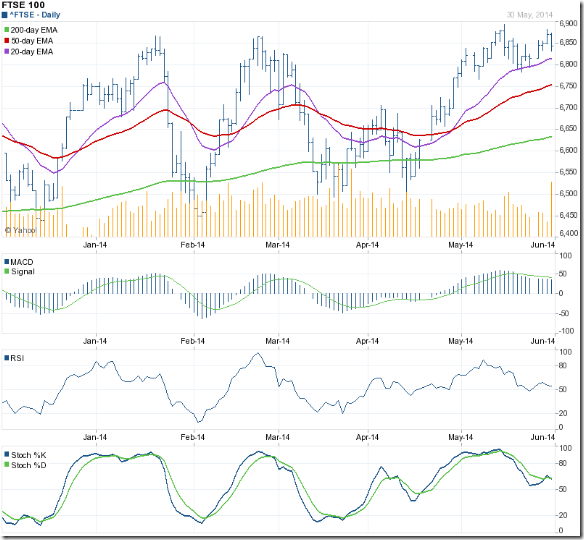S&P 500 Index Chart
The 6 months daily bar chart pattern of S&P 500 soared past its previous (May 13) top of 1902 and closed above the 1920 level at a new lifetime high. Concerns of a possible ‘double top’ at 1900 were left by the wayside.
Volumes picked up a bit on Friday, but overall volumes during the week were subdued. All three EMAs are rising and the index is trading above them. However, the index is a good 30 points above its 20 day EMA. That makes it prone to a correction.
Daily technical indicators are bullish, but looking overbought. MACD has entered overbought territory. RSI is rising towards its overbought zone. Slow stochastic is well inside its overbought zone.
The index is in ‘blue-sky’ territory with no known resistances. In such situations, resistance often comes from round index levels. Note the resistance from the 1900 level in April and May.
So, where will the next likely resistance be? Possibly at 1950. Stay invested with a trailing stop-loss.
FTSE 100 Index Chart
The 6 months daily bar chart pattern of FTSE 100 moved above the 6850 level but failed to test its May 15 top of 6895. It dropped to close below the 6850 level – but gained about 0.4% for the week.
Friday’s volumes were the highest in a month, which could be a sign of ‘distribution’. Selling near a previous top is quite common. All three EMAs are rising and the index is trading above them. There is no immediate threat to the long-term bull market.
Daily technical indicators are in bullish zones, but looking weak. MACD is sliding below its signal line in positive territory. RSI and Slow stochastic is falling towards their respective 50% levels.
Stay invested but maintain a stop-loss to protect profits.
Bottomline? Daily bar chart patterns of S&P 500 and FTSE 100 are in long-term bull markets. S&P 500 rose to touch a new lifetime high. FTSE 100 is consolidating after touching a new lifetime high. Book part profits or stay invested with suitable stop-losses.


No comments:
Post a Comment